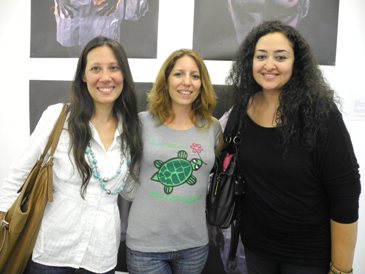Egyptians Mobilize Against Sexual Harassment

In Cairo, performers and artists take to the streets to make them safe for women.
On a hot Sunday night in Cairo, a woman wearing jeans, a loose black sweater, and a white hijab stood on an outdoor stage, quietly speaking into a microphone to share her experiences of sexual violence. Only by standing with her back to the audience of more than 100 people could she muster the courage to talk. As soon as she left the stage, her friends surrounded her, hugging her, and comforting her. Then, another woman took the stage to tell her story.
During a recent trip to Egypt, I saw dozens of brave women and their male allies share their stories and thoughts about sexual violence, especially street harassment, at an event organized by Darb 1718, BuSSy, HarassMap, and Mashrou3 Mareekh. Using spoken word, song, and an open mic session, they clearly moved the audience, more than a third of them men. May Shehab, the director of Darb 1718, said she heard a number of men say they felt angry and wanted to take action.
Their consciousness was also raised through visual art as in an exhibit entitled “Enough.” Before the spoken word began, people clustered together to view commentary about sexual harassment in mediums of chalk, colored pencils, photographs and videos.
“I’m a firm believer in using art as a vehicle for activists. It’s a way to start dialogues,” said Heba Habib, a HarassMap volunteer and co-organizer of “Enough.” Shehab agreed, calling art “one of the most effective ways to tackle harassment [because]… it evokes thought and debate.”
For Shehab, a photographic piece by Nahla Sebaei entitled “Burning Soul” was the most compelling. In four frames, a partially nude woman dressed in paper clothing is covered with flaming hand marks where harassers touched her. The caption reads, “When someone harasses me… he is burning my soul and that leaves scars in my mind and my feeling and my soul.” Shehab said she heard several people say the image perfectly captured how street harassment makes them feel.
According to a 2008 study by the Egyptian Centre for Women’s Rights, 83 percent of Egyptian women experience street harassment, and in recent months, reports of groping and sexual assault are up, especially against female protesters and journalists reporting at Tahrir Square. In response, outraged people organize initiatives like this event to share their experiences and bring attention to the issues.
Habib hopes the art from the exhibit can live on in a poster campaign on the streets of Cairo, where it would join many other anti-harassment initiatives meant to engage the general public, such as graffiti art.
Graffiti art became a popular medium for communication during the revolution in early 2011. Today members of the group Women Graffiti, like Sally Zohney, the youth initiatives associate for UN Women’s Safe Cities Programme in Cairo, display their messages on the city’s walls using anti-harassment stencils.
Zohney is also part of an initiative called Nefsy through which demonstrators form a human chain along a busy street, holding signs with statements about harassment and its impact on women. Some of the signs at a recent human chain in Cairo read, “I wish I could ride a bike without anyone bothering me,” and, “I wish you would respect me as I respect you.” The messages are often personal, causing people in their cars and on the sidewalk to slow down to read the signs. In mid-July, simultaneous human chains were staged in five Egyptian cities: Alexandria, Cairo, Giza, Mansoura, and Menoufeya.
Zohney feels that these street-based efforts are effective because the street is the location of both the problem and the solutions.
The group HarassMap works on the streets, too. Each Saturday, small groups of volunteers talk to people in their neighborhoods about street harassment. With political protests and violence popping up throughout the city without warning, plus the taboo nature of the topic, it takes great courage and determination for volunteers to do this work.
The Sexual Harassment Action Group members similarly exhibited bravery when they recently held a successful anti-harassment protest at Tahrir Square on July 6. Because a similar protest held there on June 8 abruptly ended when mobs of men harassed and chased away the protesters, the women were few in number and their male allies outnumbered them to keep them safe.
With the Islamic holy month of Ramadan underway, there will be few anti-harassment efforts until its conclusion, but planning for more continues. People hope to form another human chain in Cairo for the Eid holiday at the end of Ramadan. HarassMap wants to launch a “Safe Area” campaign. The Sexual Harassment Action Group plans to distribute materials about street harassment with whistles that women can blow when they’re harassed to bring attention to the incident and as a way to call for help.
I left Egypt inspired by the brave women and men I met who relentlessly speak out against sexual harassment and keep trying new initiatives, no matter the danger. They are determined that one day Egypt’s public places will be safe for women.
More articles by Category: Arts and culture, International, Media, Violence against women
More articles by Tag:



























